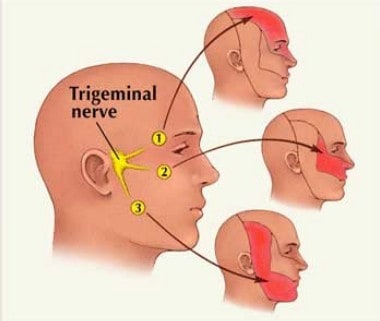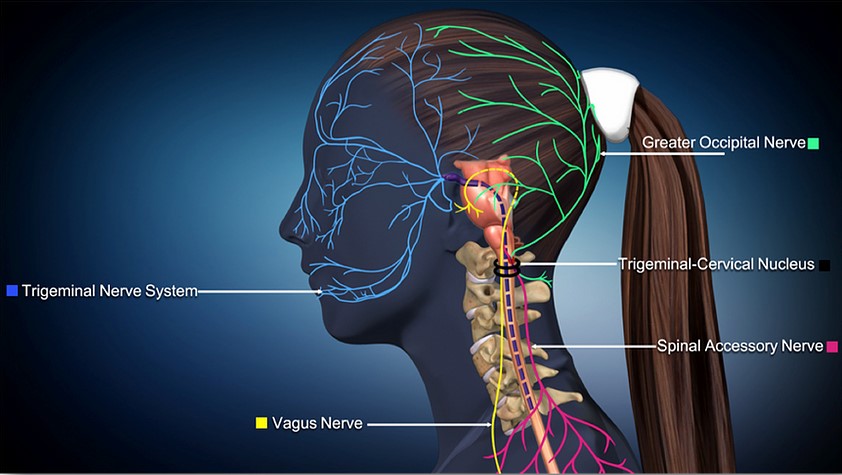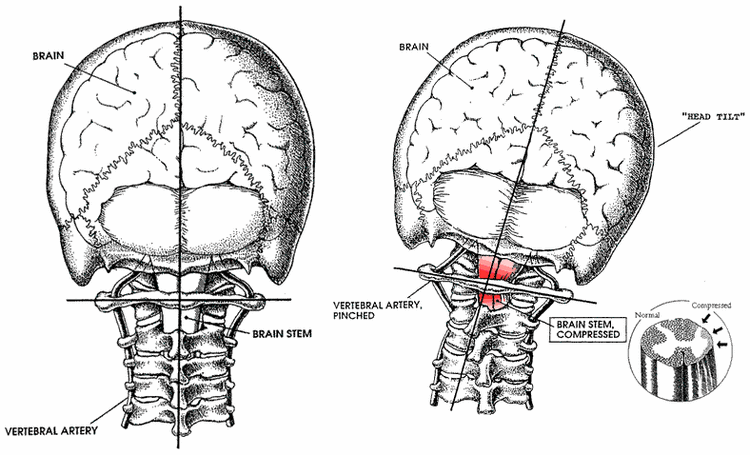Trigeminal Neuralgia
By Dr. Jason Slagel | March 11th, 2021
Trigeminal Neuralgia is a condition where there is excruciating shooting pain in someone’s face. This pain has many triggers and can be set off by even the smallest things such as a gentle brush against the face or jaw movement. If you have ever gotten something stuck in your eye you have experienced Trigeminal Nerve pain. The same nerve that causes all that hurting and scratching and intense irritation in your eye is the same nerve involved in Trigeminal Neuralgia.
Imagine that pain amplified and spread across a region of your face sporadically for years. That gives you a tiny glimpse into the extreme pain this condition can cause.
The places the pain from Trigeminal Neuralgia can be felt are shown in the picture below. As you can see, the Trigeminal Nerve has 3 main branches (thus, the prefix “Tri”). The top branch, called the Ophthalmic Branch (same root word as Ophthalmologist, meaning eye) goes to the top of the head, forehead, eyes, and nose. The second branch, called the Maxillary Branch, goes to the cheek and top lip. The third branch called the Mandibular Branch (same root word as mandible, another name for your jaw) goes in front of your ear and down the length of your jaw.

What is happening with Trigeminal Neuralgia is that the Trigeminal Nerve is being compressed or irritated and the signals being sent from its nerve endings in the face are being distorted and then interpreted in the brain as pain. This is like if you have a bad reception on the phone and the person on the other end says “I think I’m gonna make it. I’m taking a shortcut,” and you hear “I think I’m getting naked. I’m taking my shorts off.”

That person receiving that message will probably respond much differently than the person sending the message intended. This could create a very problematic situation. Much like this unfortunate miscommunication, the signals from the nerve endings in the face are saying that the face is doing just fine, but somewhere along that nerve’s path to the brain, the signal is being disrupted so that when it gets to the brain, the brain hears that it is actually extremely painful. This means that whatever is disrupting the signal is somewhere between the nerve endings in the face and the final synapses in the brain. It’s like that game where you have two cups with the string connecting them.

If the string is untouched and positioned correctly, the sound travels through the string just fine when you talk into the cup on one side, but when someone stands in the middle and grabs the string, you can no longer hear clearly. This disruption in the middle of the Trigeminal Nerve has to be corrected and eliminated in order for the pain to stop, much like taking the person’s hand off the string.
There are a few major places that the Trigeminal Nerve can be disrupted along its path. By far the most common is at the level of the brainstem. The pictures below show this location and what the Trigeminal Nerve path looks like along the way.

Without getting too technical, the Trigeminal Nerve brings the sensations of the face to the brain, and along the way, the Trigeminal Nerve passes through what is called the Trigeminal Cervical Nucleus. You can see where the Trigeminal Cervical Nucleus is located in the picture above. As you can see, it is in the exact same area as the Atlas bone, the top bone in your neck. The Atlas is responsible for most of the motion of your head, so since it is so mobile, it’s not very stable. This is why it can be shifted out of place easier than any other bone in the spine. The atlas surrounds the brainstem, which is why when the atlas shifts out of place it can put pressure on the brainstem. The picture below shows what this can look like.

The very unfortunate part of this problem for some people is that the Trigeminal Cervical Nucleus can also be affected by this shift of the atlas. When the Trigeminal Cervical Nucleus is effected, then it can distort or disrupt the signals being sent from the face to the brain through the Trigeminal Nerve, making that person feel excruciating pain in their face.
The way we correct this problem is by addressing the root issue, which is the shift of the atlas out of position. We take extremely precise x-rays of the head and neck and measure that shift down to 1/100th of a degree from all three dimensions. Then, we can measure exactly how the atlas has shifted out of place and we can calculate how to correct it. This is all without any twisting, cracking, or popping. Once the atlas is corrected back to its proper position, the pressure and irritation in that area of the brainstem, and specifically the Trigeminal Cervical Nucleus, can be gone. This means the Trigeminal Neuralgia can actually resolve and get better.
If you would like to look into this more, here are a few links to research that has been published on this topic regarding structural chiropractic care (also called Upper Cervical Care) and Trigeminal Neuralgia.
- Upper Cervical Subluxation 1
- Upper Cervical Subluxation 2
- Upper Cervical Subluxation 3
- Upper Cervical Subluxation 4
If you would like to read a short book written by a structural chiropractic patient, James Tomasi, who experienced relief from his Trigeminal Neuralgia, then here is a link to the book called What Time Tuesday? Be sure to read the comments as well. When they discuss “Upper Cervical Chiropractic” it is the same thing as “Structural Chiropractic” but just another name for it.
Stay One Step Ahead of Pain
Request a complimentary consultation today using the button below or contact our office at +1 954 842 2677 to see if Structural Spinal Care is right for you.
